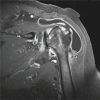Rheumatoid arthritis: what do MRI and ultrasound show
- PMID: 28439423
- PMCID: PMC5392548
- DOI: 10.15557/JoU.2017.0001
Rheumatoid arthritis: what do MRI and ultrasound show
Abstract
Rheumatoid arthritis is the most common inflammatory arthritis, affecting approximately 1% of the world's population. Its pathogenesis has not been completely understood. However, there is evidence that the disease may involve synovial joints, subchondral bone marrow as well as intra- and extraarticular fat tissue, and may lead to progressive joint destruction and disability. Over the last two decades, significant improvement in its prognosis has been achieved owing to new strategies for disease management, the emergence of new biologic therapies and better utilization of conventional disease-modifying antirheumatic drugs. Prompt diagnosis and appropriate therapy have been recognized as essential for improving clinical outcomes in patients with early rheumatoid arthritis. Despite the potential of ultrasonography and magnetic resonance imaging to visualize all tissues typically involved in the pathogenesis of rheumatoid arthritis, the diagnosis of early disease remains difficult due to limited specificity of findings. This paper summarizes the pathogenesis phenomena of rheumatoid arthritis and describes rheumatoid arthritis-related features of the disease within the synovium, subchondral bone marrow and articular fat tissue on MRI and ultrasound. Moreover, the paper aims to illustrate the significance of MRI and ultrasound findings in rheumatoid arthritis in the diagnosis of subclinical and early inflammation, and the importance of MRI and US in the follow-up and establishing remission. Finally, we also discuss MRI of the spine in rheumatoid arthritis, which may help assess the presence of active inflammation and complications.
Keywords: early arthritis; imaging; magnetic resonance imaging; rheumatoid arthritis; ultrasonography.
Conflict of interest statement
Authors do not report any financial or personal links with other persons or organizations, which might negatively affect the contents of this publication and/or claim authorship rights to this publication.
Figures













References
-
- Narváez JA, Narváez J, De Lama E, De Albert M. MR imaging of early rheumatoid arthritis. Radiographics. 2010;30:143–165. - PubMed
-
- Boutry N, Morel M, Flipo RM, Demondion X, Cotton A. Early rheumatoid arthritis: a review of MRI and sonographic findings. AJR Am J Roentgenol. 2007;189:1502–1509. - PubMed
-
- Freeston JE, Bird P, Conaghan PG. The role of MRI in rheumatoid arthritis: research and clinical issues. Curr Opin Rheumatol. 2009;21:95–101. - PubMed
-
- Sudoł-Szopińska I, Jurik AG, Eshed I, Lennart J, Grainger A, Østergaard M, et al. Recommendations of the ESSR Arthritis Subcommittee for the Use of Magnetic Resonance Imaging in Musculoskeletal Rheumatic Diseases. Semin Musculoskelet Radiol. 2015;19:396–411. - PubMed
Publication types
LinkOut - more resources
Full Text Sources
Other Literature Sources
Medical
